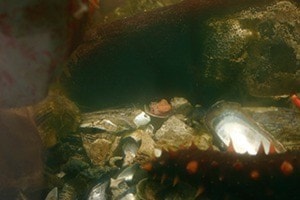When the Federal Department of Fisheries and Oceans installed the salt-water tank in the Nature Education Centre in 2006, they never envisioned that tank to become a nursery, however, that’s exactly what happened beginning in September.
“The tank was designed for the program Sea to Stream to teach the public about life in inter-tidal areas of the ocean,” Erin Robinson, NERC coordinator said.
“The tank was stocked with primarily invertebrates with one scuplin fish.”
This colony include several sea anemones of which one set of parents have given birth to a tiny offspring.
Now, before anyone gets excited about this seasonal birth, the little one is just that, very little, hardly a speck in its rock nursery at the bottom of the tank.
“This baby is the first in-tank birth at the centre,” Robinson said.
“Sea anemone births in captivity are extremely rare. Just having anemones in captivity is rare as there are regulations as to who and where these creatures can be housed outside their natural habitat.”
She said in early October she noticed both the male and female anemone were releasing stuff, the female sort of gelatinous eggs and the mail rope-like strands.
“At first I thought something was wrong,” Robinson admitted.
“However, when I noticed the gel balls floating around and then one had settled under the rock ledge, I figured it was a baby. Although at that stage it looked like a pink smear.”
Now the baby is at least four times bigger than when she was first noticed. Robinson has decided the baby’s birthday is Nov. 8, the date Robinson figured the gel egg became viable.
Sea anemones are difficult to determine gender but Robinson said they’ve been referring to the baby as “she.”
“Maybe because of its pink colour,” she said with a smile.
Sea anemones were one of the first creatures to appear on earth. They are basically a small sac (polyp) attached to the bottom by an adhesive foot, with a column shaped body ending in an oral disc. The mouth is in the middle of the oral disc, surrounded by tentacles armed with unique cells that function as a defense and as a means to capture prey by stinging and releasing a toxin.
When the hair is touched, it mechanically triggers the cell explosion which fires a harpoon-like structure, with attaches to organisms that trigger it and injects a dose of poison in the flesh of the aggressor or prey.
This gives the anemone its characteristic sticky feeling.
Although similar to jellyfish, they remain attached to a surface whereas jellyfish float around. Sea anemones are also similar to coral except they are bigger and live as live, solitary somewhat mobile polyps rather than part of a fixed colony.
They take in oxygen and expel carbon dioxide and reproduce by dividing into two pieces (fission), by budding and by eggs. Eggs and sperms are formed in partitions in the body cavity and ejected through the mouth. The eggs are fertilized by sperm in the water. The fertilized egg develops into free-swimming larvae which develops into an anemone.
“Sea anemones are very hardy, surviving in the extreme tidal conditions,” Robinson added.
“They are also relatively self-sufficient.”
Robinson cleans the 178-litre salt-water tank once a week. She replaces just half the salt water and the inhabitants, include the baby anemone, stay in the tank. She also feeds each creature separately every couple of days.
That includes the sea anemones, starfish, sea cucumbers, sea urchins, hermit crab (of which one is blind making feeding particularly difficult), mussels, oysters, shrimp and barnacles – oh and the sculpin who must catch his food as it floats (that’s just how he functions.)
However, baby anemone has no name and the NERC staff are hoping the public will help. Name nominations are being accepted until the end of January and the child whose name is chosen receives a prize.
To enter the contest, email Baker Creek Enhancement Society at bces@telus.net, or drop by the centre but call first, 250-992-5833, to ensure Robinson is on site as she also has off-site activities including taking a mobile salt-water tank to various classrooms.
Even before baby anemone came along, Robinson said the salt-water tank has provided thousands of hours of enjoyment for visitors to the centre in West Fraser Timber Park.
“The tank is constantly changing and always fascinating,” she said.
And if you’re very lucky and the timing is right, you might just have a chance to hold one of the creatures, its an amazing experience.
